
FACULTY OF ARTS AND SCIENCES
Department of English Translation and Interpreting
GEAR 212 | Course Introduction and Application Information
| Course Name |
Basic Photography
|
|
Code
|
Semester
|
Theory
(hour/week) |
Application/Lab
(hour/week) |
Local Credits
|
ECTS
|
|
GEAR 212
|
Fall/Spring
|
2
|
2
|
3
|
6
|
| Prerequisites |
None
|
|||||
| Course Language | ||||||
| Course Type |
Second Foreign Language
|
|||||
| Course Level |
-
|
|||||
| Mode of Delivery | - | |||||
| Teaching Methods and Techniques of the Course | DiscussionQ&ACritical feedbackApplication: Experiment / Laboratory / WorkshopLecture / Presentation | |||||
| Course Coordinator | ||||||
| Course Lecturer(s) | ||||||
| Assistant(s) | - | |||||
| Course Objectives | The main objective of the course is to develop a working knowledge of photography through the application of skills regarding camera choices, lens choices, camera operation (aperture/shutter speed/ISO), lighting, composition and image processing. Through a series of genre-oriented assignments, students will learn to shoot and edit according to assignments/client briefs. |
| Learning Outcomes |
The students who succeeded in this course;
|
| Course Description | Through bi-weekly assignments, students are expected to produce photographs according to the demands/technical requirements of the following genres: street photography, architectural photography, product photography, and fashion photography. |
|
|
Core Courses | |
| Major Area Courses | ||
| Supportive Courses | ||
| Media and Management Skills Courses | ||
| Transferable Skill Courses |
WEEKLY SUBJECTS AND RELATED PREPARATION STUDIES
| Week | Subjects | Related Preparation |
| 1 | Introduction | |
| 2 | History of Photography & Photography Basics | Davenport, A., 1991, The History of Photography, Focal Press: Boston, ISBN: 0-8263-2076-7 p.3-29. Turner, P., 1987, History of Photograph, Bison Books Corp: USA, ISBN: 0-671-08923-4, p. 11-35. Stuckey, S., National Geographic Complete Photography, 2011, National Geographic Society: USA, ISBN: 978-142620776, p. 9-196. |
| 3 | Photography Basics II & Assignment | Diprose, G. and Robins, J., 2012, Photography: the new basics: principles, techniques and practice, Thames&Hudson: United Kingdom, ISBN: 978-0-500-28978-5, p. 45-68 and p.113-140. |
| 4 | Project I (%10) Change your angle! | |
| 5 | Project I Continues & Adobe Camera Raw Workshop | Sheppard, R., 2008, Adobe Camera Raw For Digital Photographers Only, 2nd ed., Wiley Publishing: Indiana, ISBN: 978-0-470-22457-1, p.73-266. |
| 6 | Project II (%10) Portrait Photography & Basics of Photostudio Equipment | Child, J. , Studio Photography Essential Skills, 2008, 4th ed., Focal Press: Canada, ISBN: 978-0-240-52096-4, p. 45-126 Lewinski, J. and Magnus, M., The Book of Portrait Photography, 1982, Alfred A. Knopf Inc. : New York, ISBN: 978-0394524689, p.6-72 Smith, B., Secrets of Great Portrait Photography: Photographs of the Famous and Infamous, 2013, New Riders: USA, ISBN: 978-0-321-80414-3, p. 18-194 |
| 7 | Project II Continues | |
| 8 | Project III (%10) Indoor & Outdoor Fashion Photography | Siegel, E, 2008, The Fashion Photography Course: First Principles to Successful Shoot - the Essential Guide, Thames&Hudson: London, ISBN: 978-0-500-28769-9, p.10-99. |
| 9 | Project III Continues | - |
| 10 | Project IV (%10) Still Life Photography | Perweiler, G., 1984, Secrets of Studio Still Life Photography, Amphoto: New York, ISBN: 0-8174-5898-0, p.6-133 |
| 11 | Project IV Continues & Project V (%10) A day in your life | - |
| 12 | Photoshoot Event | |
| 13 | Project V Continues | |
| 14 | Project V Continues & Portfolio Submission Brief | |
| 15 | Semester Review | Portfolio Submission |
| 16 | Semester Review |
| Course Notes/Textbooks | |
| Suggested Readings/Materials | Davenport, A., 1991, The History of Photography, Focal Press: Boston, ISBN: 0-8263-2076-7 p.3-29 Turner, P., 1987, History of Photograph, Bison Books Corp: USA, ISBN: 0-671-08923-4, p. 11-35 Stuckey, S., National Geographic Complete Photography, 2011, National Geographic Society: USA, ISBN: 978-142620776, p. 9-196 Diprose, G. and Robins, J., 2012, Photography: the new basics: principles, techniques and practice, Thames&Hudson: United Kingdom, ISBN: 978-0-500-28978-5, p. 45-68 and 113-140 Sheppard, R., 2008, Adobe Camera Raw For Digital Photographers Only, 2nd ed., Wiley Publishing: Indiana, ISBN: 978-0-470-22457-1, p.73-266 Lewinski, J. and Magnus, M., The Book of Portrait Photography, 1982, Alfred A. Knopf Inc. : New York, ISBN: 978-0394524689, p.6-72 Smith, B., Secrets of Great Portrait Photography: Photographs of the Famous and Infamous, 2013, New Riders: USA, ISBN: 978-0-321-80414-3, p. 18-194 Child, J. , Studio Photography Essential Skills, 2008, 4th ed., Focal Press: Canada, ISBN: 978-0-240-52096-4, p. 45-126 Siegel, E, 2008, The Fashion Photography Course: First Principles to Successful Shoot - the Essential Guide, Thames&Hudson: London, ISBN: 978-0-500-28769-9, p.10-99 Perweiler, G., 1984, Secrets of Studio Still Life Photography, Amphoto: New York, ISBN: 0-8174-5898-0, p.6-133 |
EVALUATION SYSTEM
| Semester Activities | Number | Weigthing |
| Participation |
1
|
10
|
| Laboratory / Application | ||
| Field Work | ||
| Quizzes / Studio Critiques | ||
| Portfolio |
1
|
30
|
| Homework / Assignments |
1
|
10
|
| Presentation / Jury | ||
| Project |
1
|
50
|
| Seminar / Workshop | ||
| Oral Exams | ||
| Midterm | ||
| Final Exam | ||
| Total |
| Weighting of Semester Activities on the Final Grade |
4
|
100
|
| Weighting of End-of-Semester Activities on the Final Grade | ||
| Total |
ECTS / WORKLOAD TABLE
| Semester Activities | Number | Duration (Hours) | Workload |
|---|---|---|---|
| Theoretical Course Hours (Including exam week: 16 x total hours) |
16
|
2
|
32
|
| Laboratory / Application Hours (Including exam week: '.16.' x total hours) |
16
|
2
|
32
|
| Study Hours Out of Class |
14
|
2
|
28
|
| Field Work |
0
|
||
| Quizzes / Studio Critiques |
0
|
||
| Portfolio |
1
|
28
|
28
|
| Homework / Assignments |
1
|
10
|
10
|
| Presentation / Jury |
0
|
||
| Project |
5
|
10
|
50
|
| Seminar / Workshop |
0
|
||
| Oral Exam |
0
|
||
| Midterms |
0
|
||
| Final Exam |
0
|
||
| Total |
180
|
COURSE LEARNING OUTCOMES AND PROGRAM QUALIFICATIONS RELATIONSHIP
|
#
|
Program Competencies/Outcomes |
* Contribution Level
|
||||
|
1
|
2
|
3
|
4
|
5
|
||
| 1 | To be able to use advanced, field-specific conceptual, theoretical, and practical knowledge acquired, |
|||||
| 2 | To be able to analyze and research field-specific concepts and ideas and to interpret data individually or as a team using scientific methods, |
|||||
| 3 | To be able to understand and use grammatical and semantic structures of the source and target languages, |
|||||
| 4 | To be able to obtain information about social, cultural, and historical approaches within the source and target languages and to use this information for textual analysis and production, |
|||||
| 5 | To be able to understand and interpret written and oral texts in the source language and to transfer these texts into the target language using a semantically and functionally appropriate language, |
|||||
| 6 | To be able to produce creative translations and assess the translation products critically by defining the steps, strategies and problems in the translation process in the light of field-specific theoretical knowledge and skills acquired, |
|||||
| 7 | To be able to transfer the theoretical knowledge and research skills within different areas of expertise to translational act, |
|||||
| 8 | To be able to use computer-assisted translation tools and machine translation effectively at each step of the translation process, and to follow the theoretical and practical developments in these fields, |
|||||
| 9 | To be able to gain awareness of the translator’s social role, job profile, and professional ethical values and to acquire workload management skills for individual or team work, |
|||||
| 10 | To be able to access necessary sources to improve quality at each step of the translation process and to assess the target text in accordance with the quality objectives by using these sources, |
|||||
| 11 | To be able to establish effective oral and written communication skills both in English and Turkish, to be able to speak a second foreign language at a good level, to be able to use a third foreign language at intermediate level, |
|||||
| 12 | To be able to relate the knowledge accumulated throughout the human history to their field of expertise. |
|||||
*1 Lowest, 2 Low, 3 Average, 4 High, 5 Highest
NEWS |ALL NEWS
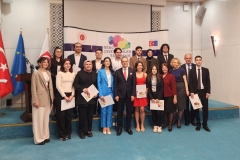
Young Translators from İzmir University of Economics Received Their Awards.
On April 16, 2024, in Ankara, the Directorate for EU Affairs hosted the Certificate Ceremony for the "Young Translators Competition," where 125
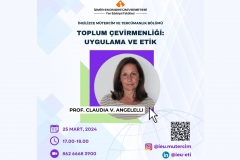
IUE Department of English Translation and Interpreting hosted Prof. Dr. Claudia V. Angelelli in the webinar titled "Community Interpreting: Practice and Ethics".
On Monday, March 25th, İzmir University of Economics Department of English Translation and Interpretation organized a webinar titled "Community Interpreting: Practice and
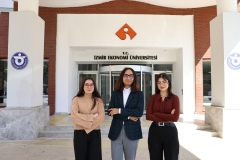
Returned to Izmir with three awards
The Young Translators Competition organized by the Ministry of Foreign Affairs Directorate for EU Affairs was marked by the success of Izmir
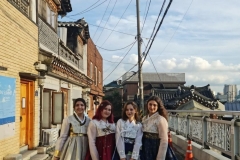
International agreements with 203 universities
Izmir University of Economics (IUE), who has signed international agreements with 203 universities with the aim of enhancing the educational opportunities offered
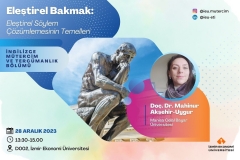
“Basics of Critical Discourse Analysis" Seminar at IUE English Translation and Interpreting Department
Izmir University of Economics, Department of English Translation and Interpreting, organized a seminar titled " Turning a Critical Eye: Basics of Critical
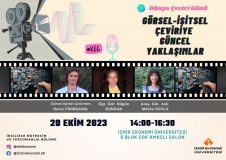
Within the framework of International Translation Day, IUE Department of English Translation and Interpreting, Faculty of Arts and Sciences, organized a panel titled "Current Approaches in Audiovisual Translation".
Within the framework of International Translation Day (September 30th), the Department of English Translation and Interpreting at Izmir University of Economics hosted
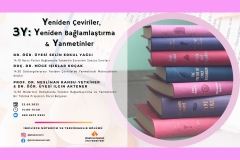
“Re-translations, Re-contextualization, and Paratexts” Panel at IUE English Translation and Interpreting Department
Izmir University of Economics, Faculty of Arts and Sciences, Department of English Translation and Interpreting organized an online panel titled "Re-translations, Re-contextualization,
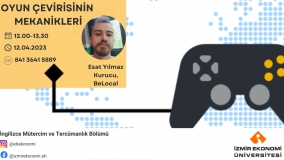
As part of the webinar series, IUE Department of English Translation and Interpreting, Faculty of Arts and Sciences, hosted Esat Yılmaz
IUE Department of English Translation and Interpreting, Faculty of Arts and Sciences, hosted Esat Yılmaz, the founder of a localization company, in



